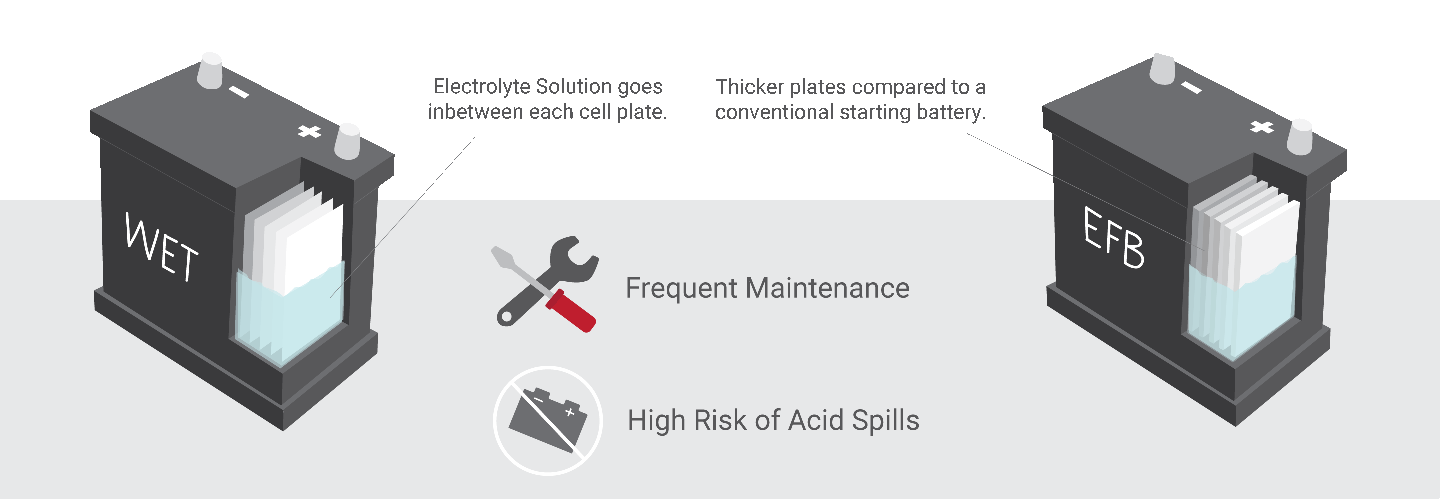Find out how your car battery stacks up compared to other types. Make sure you understand the different characteristics, how to look after them, where they should be used and how to charge them.
- Flooded batteries
- Enhanced Flooded Batteries (EFB)
- Advanced Glass Matt (AGM) batteries
- Silver Calcium batteries
- GEL cell batteries
- Charging different car battery types
If you are looking for a good charger, take a look at the CTEK MXS 5.0 charger on amazon >
Flooded or “wet cell” battery
This is one of the oldest and used to be one of the most common types of vehicle battery technology, but it is now much less common in modern vehicles. At its heart is a simple design of liquid sulfuric acid electrolyte that is separated into six cells (for a 12v battery) by lead plates and plate separators. Each cell generates approximately 2.13v in a healthy battery, making a total of 12.8v when charged.
Flooded batteries are a very cost efficient way of delivering short-term high power output to meet the demands of starting internal combustion engines (ICE). It is not suitable for deep-discharging as this will cause premature wear and shorten the service life of the battery.
Most flooded batteries are sealed these days, but there are still vented batteries in use in some vehicles and motorbikes and these can vent out electrolyte gases during use. As a result they may need to be topped up with distilled water periodically in order to avoid premature corrosion of the lead plates when they are exposed to air.
Flooded batteries have weaknesses such as stratification and sulfation that can shorten their life. Stratification is where the electrolyte falls out of solution and moves towards the bottom of the battery and can occur because of poor or slow charging. Sulfation is a situation that can occur when a battery is partially charged for long periods and results in crystals that form around the battery electrodes. Both issues can reduce battery performance (reducing charge acceptance and/or cold cranking performance) and lifespan.
Flooded batteries are less suited to modern vehicles with larger electrical demands from on-board accessories or even hybrid technologies. As a result other battery technologies, such as EFB and AGM have been developed to overcome these weaknesses and better serve the needs of modern cars.

EFB (Enhanced Flooded Battery)
The Enhanced Flooded Battery can deliver a longer cycle life because it is better suited to being deeply discharged over standard Flooded Battery technology.
Differences in technology are:
- a scrim (a polyester fleece like material) that helps ‘hold’ the electrolyte in place to reduce the likelihood of electrolyte stratification.
- Enhanced design that facilitates mixing of the electrolyte through typical vehicle movement (to further reduce the occurrence of stratification)
- Additives to prevent sulphation of the battery electrodes when left in a partial charge state and reduce corrosion.
- An optimised grid structure, thinner plates and more electrodes to improve current flow and improve voltage.
These technologies make EFB batteries just as good for starting cars (their cold cranking performance) but they have much better shallow cycling performance and durability than standard flooded batteries at only 30% more cost.
EFB batteries weight more than flooded batteries. They weigh similarly to AGM batteries but with similar performance at lower cost. They are well suited to modern vehicles with higher current draw from larger electrical accessories and stop start engine technology.
AGM (Absorbent Glass Matt) battery

AGM batteries were first used to fill the void created by modern car demands and older flooded battery technology. They can deliver higher power output together with a longer cycle-life with the downside of being heavier and are more expensive (by a factor of between 1.5x to 2x). Because their performance can often be met by newer EFB batteries of cheaper construction, they are now more commonly found only in premium or commercial vehicles.
Their enhanced performance makes them suitable for use in cars with start stop engine technology, and some hybrid cars that use regenerative braking / passive bost..
Unique features:
- Glass matt separators
- recombinant lid technology
- higher pack pressures
Silver Calcium (Or Calcium/Calcium) batteries
An improvement over Flooded Battery technology and a stop-gap before the release of the EFB car battery, as well as being an alternative to much more expensive AGM batteries.
They possess grids made with lead-calcium-silver alloy. They typically have 10% higher cold cranking performance compared with Flooded Batteries. They also have higher corrosion resistance and are more resistant to the detrimental impact of high temperature operation, which can impact cold-cranking performance, so Silver Calcium car batteries provide longer life-span in hotter climates.
They are also more suited to cars that don’t get used that often as they have a lower rate of self-discharge than standard Flooded Battery technology.
A silver Calcium battery requires a higher charging voltage and will deteriorate rapidly due to sulfation if this is not available (they require a properly performing and optimised charging system).
Never put a Silver-Calcium battery in a car that is not optimised for it. If you are charging a calcium battery, make sure that your charger can provide a higher charging voltage than standard (~14.4 to 14.8v).
GEL cell batteries

Long cycle life but the power capability is too low to deliver good cold-cranking performance.
Use silica (sand) to turn the electrolyte into a jelly like material.
Not good at handling high current flow situations (charging or discharging) – this can result in gasses forming air pockets that subsequently cause the electrodes to corrode.

Leave a Reply